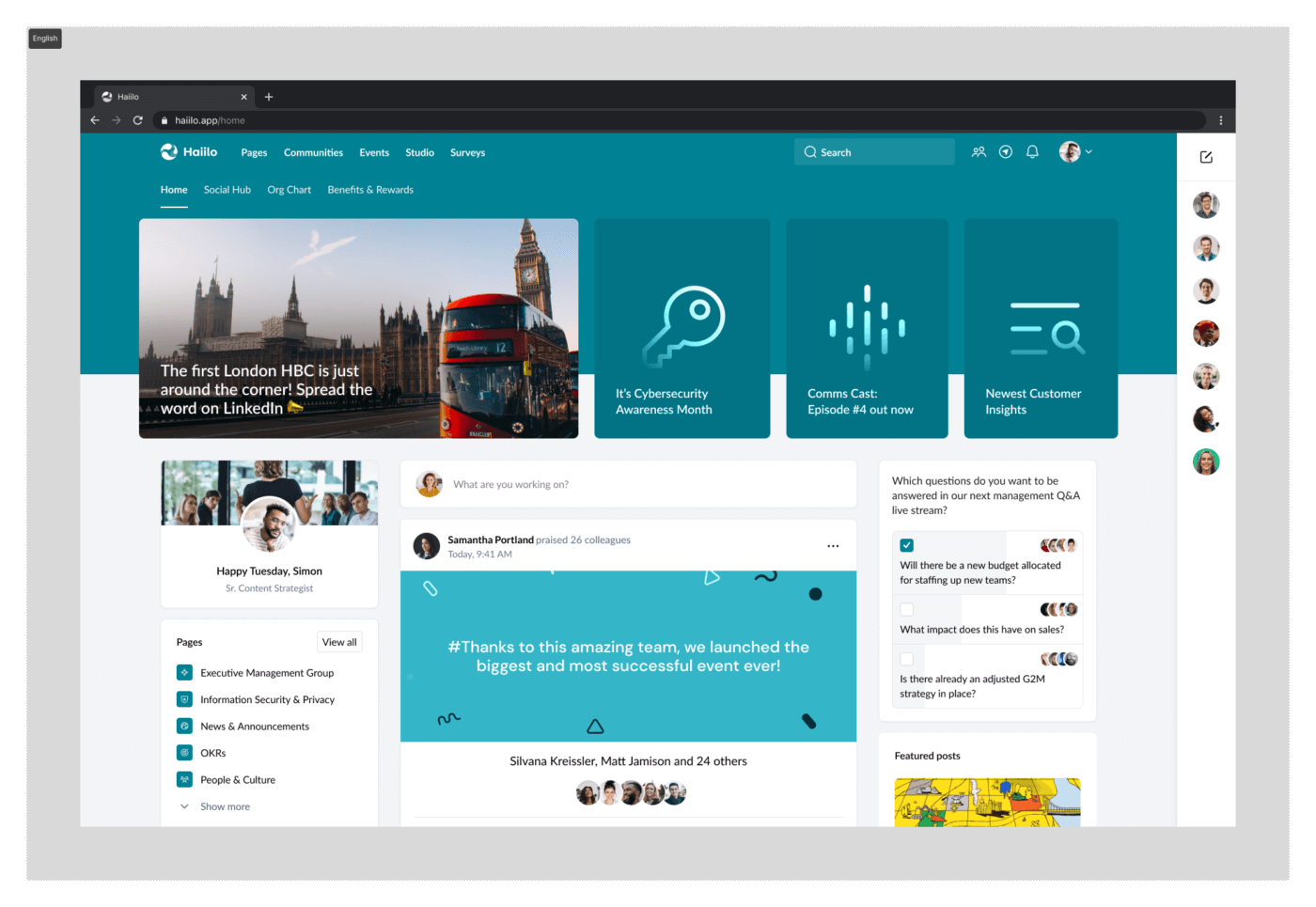So you’ve finally decided to invest in intranet software. You’ve been struggling in the past couple of years to get your employees to use the legacy intranet, but the design and the features are so user-hostile your employees would rather recreate the same documents over and over again than click on the Sharepoint icon once more. Or maybe you don’t have an intranet at all, and the sheer amount of newsletters, Teams messages and regular email updates haunts you at night.
Whatever the case might be, you’ve come to the right place! We’ve prepared a short guide to help you choose the best intranet for a large company; and best here means the one that meets your unique needs. Make sure to read till the very end as we’re going to provide you with a list of some of the best intranet vendors on the market.
7 Steps to Choose the Best Intranet
Re-evaluate your internal comms strategy
Let’s start with the basics. Your new intranet software should solve some very real internal comms problems. To find the best match, it might be helpful to review your internal comms strategy as well as the current business goals to know what you’re trying to improve with the new provider.
For example, the survey by PwC found that only 28% of employees feel truly connected to the company purpose. Unsurprisingly, this number translates into disengagement, poor performance and higher turnover rates within the organization. The right intranet software can help you connect your employes to purpose through content and communities, therefore, diminishing the effect misunderstanding and miscommunication might have on your company.

Some things to consider are:
- Increase strategy comprehension by X%
- Increase readership/engagement with content by X%
- Reach X% of employees with updates
- Increase the number of active intranet users by X%
When locking in your goals, make sure to outline how exactly you expect the new intranet software to improve the critical metrics. This will later help you get the team’s buy-in
📚Read on: Need to build a business case for the new intranet? Check out our article on how to communicate the ROI of the intranet software!
Let our experts help you define your intranet needs!
Define internal audiences
Every communicator has to understand their target group first. Establishing employee personas (in other words, your internal audiences) is a great way to get an understanding of what preferences your employees have when it comes to consuming company content.
Here are some questions to get you started:
- What channel(s) do your employees use the most for consuming company content?
- What is your workforce’s preferred content format? Is it written content? Is it podcast? Is it video?
- How many languages do you speak in your organization? – Are you English first? Spanish first? Do you use multiple languages depending on the location and/or the department?
- How many locations your company is present in? Does it require location-specific content (think safety regulations, national holidays, etc.)?
- What is the percentage of different generations and do they express any particular preferences toward technology?
- How many blue-collar vs white-collar workers do you have?
Alongside these questions, you could also think how much personalization you’d like to have. Once you know the answers to these questions, you’ll be able to identify the features your future solution should have.
💡Pro-tip: don’t hesitate to ask your employees! Create a simple survey with these questions to get a bird’s eye view over all the essential information.
Map out software requirements
You can now cross-reference the identified gaps from previous steps with the potential features you’d like to see in your software.
Revisit your overarching goals and write down how the intranet can help you in achieving those. If increasing strategy comprehension is on the list, consider investing in the intranet with a multichannel comms feature to ensure the optimal distribution of the news. To foster trust and a sense of belonging, you might want to look in the direction of a social intranet. Also, keep in mind the importance of quantitative and qualitative analytics, as more and more IC professionals need to prove the tangible impact internal comms have on the business.

Next, move on to your audiences. Connect your employee personas and their preferences with all the features and add-ons that can help convey your message to them. Don’t worry if the list gets too extensive; later, you might notice that one feature can solve two or three problems at once. At this stage, the objective is to map out the perfect intranet solution.
Assess the tools that are currently in use by the IC department. Compare these tools with your vision for the future intranet, drawing on past experiences to distinguish what works, what doesn’t, and what needs to be improved.
Once your list is complete, you can cluster the features into “must-have” and “good-to-have” categories. These are your guidelines for choosing your future software.
Often, large companies choose comprehensive yet highly customizable software. Some of the most beloved features include:
- Multichannel comms
- Targeted comms
- Calendar view
- Granular permission roles
- Solid mobile version of the intranet (some might even lean into mobile-first technology)
- Social reactions (e.g. likes and comments)
- Integrated surveys
- AI co-pilot for content creation
- White labeling
- Integrations with Microsoft365, Google Workspace,and other popular workplace tools
Decide whether you want to build or buy an intranet
The next step is deciding whether you want to build the intranet or buy an out-of-the-box solution.
Usually, when talking about building an intranet, people refer to building on top of Sharepoint. In the meanwhile, buying refers to choosing one of the existing intranet solutions on the market with pre-set features.
There are pros and cons to both approaches, and the solution depends on your particular situation. Generally speaking, building the intranet gives more versatility but can turn out to be more expensive and time-consuming as it depends heavily on IT support.

On the other hand, buying software with pre-set features, while might seem limiting, will most likely end up to be the most efficient (and cost-effective) solution. It doesn’t require much, if any, IT support as all of them are designed to be used out-of-the-box. When chosen carefully, the set of features the intranet software has to offer will match or even exceed your requirements.
📚Learn more: Should You Build or Buy an Intranet? Everything You Need to Know
Get some demos and create a short-list
When you’ve decided on the set of features your new intranet should have, you can go to G2 or Capterra and look for the best providers that meet your expectations. Make sure to filter the results by market segment, as not all intranet providers are equally good for companies of all sizes.
Some other helpful resources to help you with research are ClearBox and SoftwareReviews reports. The former focuses purely on the functionality of intranet software, while the latter takes into consideration the customer experience and the relations providers build with their customers.
Now you’re ready to create your short-list. Schedule a demo with your favorite providers, prepare the questions you’d like to ask, as well as your budget estimate. A good thing to pay attention to is how well the intranet provider is taking care of security. This detail doesn’t have to be limited to GDPR and ISO certification but could also include questions about information security training at the company of a chosen provider.
Don’t be shy! Ask as many questions as you need in order to make your decision.
Get the team’s buy-in
It’s crucial to identify the stakeholders who will have an effect on the project and address their concerns from the get-go. People from HR and IC departments will probably want to know more about the functionality of the intranet and how it will affect their daily business; IT and security teams will be interested in implementation, while the C-level will want to look at cost efficiency and how the new software will save or bring money. Use the information you already have on your hands to justify your choice.
When addressing senior leadership, it’s good to put together some estimates of how the new software will affect the company’s bottom line. If you’re struggling with sourcing the numbers, you can also draw on your previous experience with the current provider to underscore the necessity of change or use the success stories of your chosen vendors to emphasize the influence the intranet has on business.
Finally, establish metrics to track the success of the intranet software implementation, such as user engagement, productivity improvements, and cost savings. Use this data to iterate and make improvements as needed, ensuring the long-term success of the new system.
💡Read on: Looking for the Story Behind the Numbers
Sign the contract. Drive adoption
Now that you’ve got that final approval, it’s time to proceed with the purchase and implementation. Depending on your internal resources, you might want to consider getting onboarding and extensive customer support as part of your package.
Remember to communicate the timeline and tasks with respective stakeholders. You might even want to run simple internal marketing campaigns to create some buzz around the launch of your new intranet. After all, the more your employees are excited about the tool, the more engaged they will be once it’s out there.
The Benefits of Having the Right Intranet for Your Organization
Improved knowledge management
Probably the most noticeable benefit of having the right intranet software for your company is streamlined knowledge management. According to McKinsey, an employee spends roughly 2 hours per day searching for information. That’s a lot of wasted productivity. Not to mention that having to search for task-relevant information decreases the ability to focus and, therefore, influences the outcome.
When employees love using the intranet, they will be proactive in sharing important information with their colleagues. Having necessary information available at hand will not only increase employees’ productivity but will also decrease the levels of work-related stress, positively affecting their well-being.
Easier onboarding
This is a natural outcome of the previous point. The right intranet software will serve as a single source of truth, which will make onboarding easier, saving your company time and valuable resources on getting new hires up to speed.
Eliminates cross-departmental silos
More than half of the companies suffer from the consequences of siloed communication. Intranet software improves information workflow and, therefore, decreases the possibility of communication siloes. Employees also get better visibility into other departments, which has a positive influence on increasing transparency and a sense of belonging.

Strengthens employee communities
As discussed in previous articles, employee communities are one of the best ways to increase employee engagement and create an emotional connection between employees and the business. And the best news is that building employee communities doesn’t have to be limited to physical spaces.
Many modern intranet solutions provide community-building features, such as social reactions and the possibility to create your own interest-based pages. When employees have the option to share their opinions, when they feel like their input matters, and, in fact, they can share their expertise, they develop a true sense of belonging, which translates into higher levels of engagement.
Increased strategy comprehension
According to Harvard Business Review, as much as 95% of employees report not understanding the company strategy. Unsurprisingly, this number translates into low employee morale and inevitably leads to poor business performance. On the other hand, when employees know what is expected of them and are aligned around the same purpose, they are more likely to go above and beyond to achieve this goal.
Intranet software enables IC professionals to keep clear and streamlined communications around company goals. They can regularly revisit the workforce sentiment around understanding the company’s purpose by leveraging employee listening tools and send relevant communications to the right audiences at the right time.

Increased trust in leadership
Trust is fast becoming one of the most important metrics of a successful business. And it’s no surprise since when the trust in leadership (and, by extension, in the company) is low, employees start looking elsewhere and ultimately quit their jobs. The research shows that trust leads to 50% higher productivity and 106% more energy at work.
Having the right intranet software enables leaders to address their employees’ worries and explain the thought process behind this or that decision. The lack of time constraints on virtual communication prompts leaders to share their thoughts more often, which inevitably leads to higher levels of trust among employees.
Increased data security
Having your data and other documents scattered around different tools with vague permission roles is a sure way to a security threat. Using the intranet as a single data point to share all the information is of paramount importance to data security. Most of the modern intranet solutions are GDPR and ISO-certified and require two-factor authentication, which ensures your data is safe.
The Best Intranet Software for Large Companies
Of course, this article won’t be complete without a list of the best intranet providers on the market. Here are the top customer picks in the internal communications and intranet categories:
- Haiilo
- Lumapps
- Happeo
- Staffbase
- Workvivo
- Firstapp
- Unily
- Interact
We’ve also published an extensive guide on how different intranet providers stack against each other, their strengths and weaknesses, alongside customer quotes. If you want to learn more in detail about different solutions, click here.
Alternatively, you might want to look into other product categories that will be a better fit for your needs. Here’s some further reading to help you in your search process:









